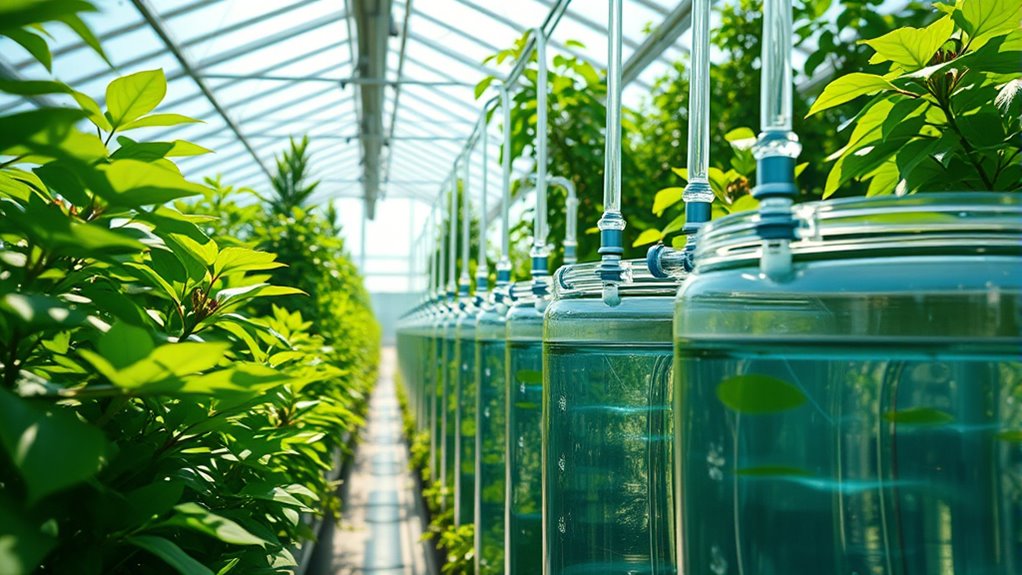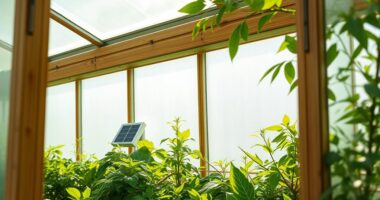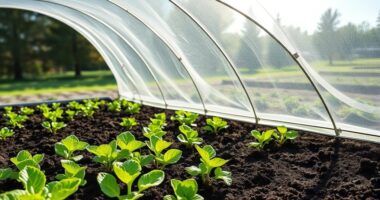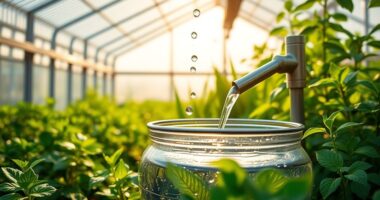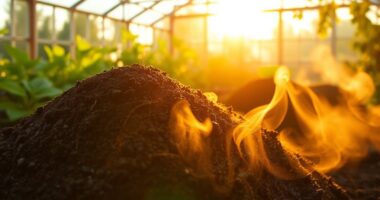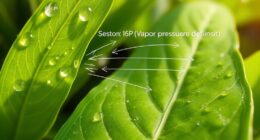To create a closed-loop water system in your greenhouse, you’ll capture and filter runoff from plants and surfaces, recycle it through biological filters or UV sterilization, and monitor water quality regularly. You’ll need to balance water input and output, manage nutrient levels carefully, and maintain pumps and filters to guarantee system efficiency. Implementing these steps boosts water conservation and promotes healthy plant growth. Keep exploring to discover more ways to optimize your system.
Key Takeaways
- Implement water recycling by capturing runoff, filtration, and reuse for continuous water efficiency.
- Regularly test and adjust nutrient levels in recycled water to prevent imbalances.
- Use filtration, UV sterilization, and sensors to maintain clean, pathogen-free water.
- Balance water input and output, replenishing with sustainable sources like rainwater.
- Maintain system components to ensure consistent operation and maximize sustainability benefits.
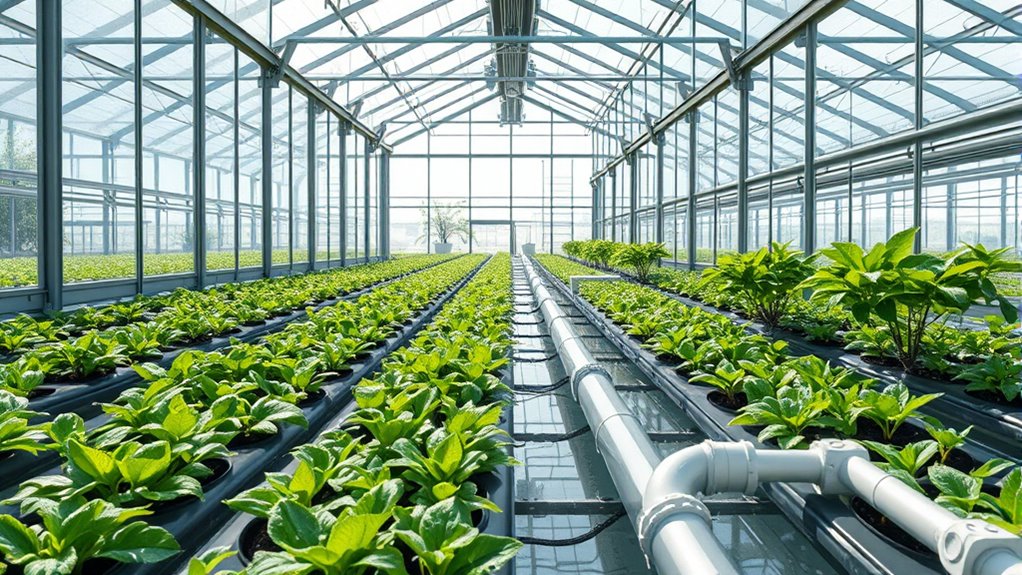
Implementing a closed-loop water system in greenhouses offers a sustainable way to conserve water and reduce operational costs. By establishing a system where water is continuously recycled within your greenhouse, you minimize waste and maximize efficiency. Water recycling becomes central to this approach, allowing you to reuse water multiple times, which substantially lowers your overall water consumption. This not only benefits the environment but also translates into cost savings on water bills. As you design your closed-loop system, you’ll need to carefully consider how to capture, filter, and reuse water while maintaining ideal conditions for your plants.
Effective nutrient management plays an essential role in making this system work seamlessly. When water is recycled, nutrients from fertilizers and plant exudates accumulate in the system, which can lead to imbalances if not properly managed. You’ll want to implement a nutrient monitoring process to ensure plants receive the right amounts without excess buildup. This often involves regular testing and adjusting nutrient concentrations, preventing issues such as nutrient lockout or toxicity. Proper nutrient management also reduces the need for excessive fertilizer use, contributing further to sustainability and cost efficiency.
To maximize water recycling, you’ll need to design a filtration and treatment setup that removes debris, pathogens, and excess salts. This ensures that recycled water remains clean and safe for plants. Incorporating biological filters or UV sterilization can help manage microbial populations, preventing disease spread. Additionally, a system for collecting runoff water from benches, floors, and gutters ensures that every drop is captured and reused. By integrating sensors and automation, you can monitor water quality, pH levels, and nutrient concentrations, adjusting flows as needed to maintain a healthy growing environment.
Another key aspect is balancing water input and output. You’ll need to establish procedures for replenishing water lost through evaporation and transpiration, ensuring your system stays at the desired water level. Using rainwater collection or connecting to a sustainable water source can further enhance your system’s eco-friendliness. Regular maintenance of pumps, filters, and reservoirs is essential to prevent clogging and ensure consistent operation. Incorporating soil health principles can further improve the efficiency of your water and nutrient cycle.
In essence, creating a closed-loop water system in your greenhouse isn’t just about saving water; it’s about creating a sustainable cycle that supports healthy plant growth while minimizing environmental impact. Proper water recycling techniques combined with meticulous nutrient management will help you achieve a resilient, efficient, and cost-effective growing environment. With thoughtful planning and ongoing adjustments, you’ll develop a system that benefits your crops, your budget, and the planet.
Frequently Asked Questions
What Are the Initial Costs of Installing a Closed-Loop Water System?
The initial costs of installing a closed-loop water system vary based on your greenhouse size and setup. You should expect a cost estimation that includes equipment expenses like pumps, filters, and storage tanks, which can range from several thousand to tens of thousands of dollars. While the upfront investment might seem high, these costs are offset by savings on water and energy over time, making it a worthwhile investment.
How Often Does the Water Need to Be Tested and Treated?
Water quality needs regular review, so you should test your system’s water weekly to guarantee optimal operation. Testing frequency depends on your system’s size and plant types, but weekly checks keep water pure and prevent problems. Treat the water as needed to eliminate contaminants, maintain clarity, and promote healthy growth. Consistent testing and treatment keep your closed-loop water system clean, clear, and continuously cycling smoothly.
Can the System Be Automated for Maintenance and Monitoring?
Yes, you can automate your closed-loop water system using sensor integration and predictive analytics. By installing sensors to monitor water quality, flow, and temperature, you enable real-time data collection. This data feeds into predictive analytics, which can forecast maintenance needs and automatically trigger adjustments or alerts. This setup reduces manual oversight, guarantees ideal water quality, and keeps your system running efficiently with minimal intervention.
What Are Common Challenges Faced During System Implementation?
During system implementation, you’ll face challenges like preventing system leakage, which can lead to water loss and inefficiency. Microbial contamination is another concern, risking plant health and water quality. You need to make certain of proper sealing and regular maintenance to avoid leaks, while maintaining hygiene protocols to control microbes. Addressing these issues early helps you create a reliable, sustainable closed-loop water system that supports healthy greenhouse operations.
How Does a Closed-Loop System Impact Overall Greenhouse Energy Use?
A closed-loop system subtly transforms your greenhouse into an energy-efficient haven, reducing overall energy use. By enhancing water conservation, it minimizes the need for external water sources, which in turn lowers energy consumption associated with water heating and pumping. This interconnected approach streamlines operations, helping you save energy while maintaining *best* plant growth. Ultimately, it fosters a more sustainable environment, making your greenhouse more resilient and environmentally friendly.
Conclusion
Think of your greenhouse as a delicate eco-cycle, where water flows like a well-tuned orchestra, never missing a beat. By creating a closed-loop system, you become the conductor, ensuring every drop is reused and every plant thrives. This sustainable rhythm not only conserves water but nurtures a healthier environment. Embrace this harmony, and you’ll transform your greenhouse into a vibrant, self-sustaining oasis—an everlasting dance of growth and renewal.
